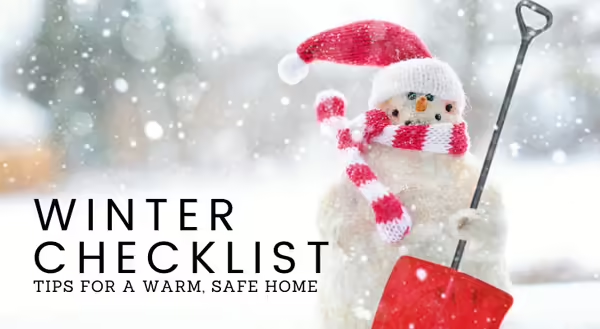
With the way this year has been going, I wanted to get a head start on preparing my home for cold temperatures before old man winter makes a full appearance. Taking steps to get your house ready for colder weather can save you money and help you and your family stay safe and warm.
Each year, I start with this checklist of tips for winter home prep to keep the cold out and the heat in:
Get your furnace checked
According to the Department of Energy, heating your space is the largest expense in the average U.S. home. Getting your furnace checked by a technician now could save you from an emergency when it’s really cold outside. When a technician comes to check your furnace, they should make sure the pilot light and thermostat are working, check for leaks or cracks as well as the efficiency of your furnace.
Unplug appliances when traveling
If you plan to travel for a week or more, try to unplug appliances to reduce your utility bill. Things like the coffee pot, toaster, and TV don’t need to stay plugged in if you’re not there. Another option is to purchase a SMART power strip. That way you can keep on the things you want, but turn the rest of the electronics off just with the flick of a switch.
Prepare for snow
Research and purchase all of the essentials for your home now: things like shovels, snowblowers, and rock salt. If you’re not sure which types of snow removal equipment you need, check out Consumer Report's buying guides for snowblowers and snow shovels to compare features and styles.
Add weather stripping
Weatherstripping includes things like window insulator kits and foam for your doors and windows. This is one way to keep cold air from coming into your home. Some of these may be two-person projects so make sure you have enough hands on deck to help out, if necessary.
Inspect your chimney
If you’re planning on using your chimney this winter, make sure to get it inspected. According to the CDC, you can ask your local fire department to recommend an inspector or find one in the yellow pages under “chimney cleaning”.
Get a thermometer
Knowing the temperature of your home may be difficult if you don’t have central heat and air. This is one handy tool to purchase to find out how warm/cool your room is this winter. This could also help you identify drafts or rooms that are losing heat quickly.
Check or update your thermostat
If you have a manual or programmable thermostat, check with your energy delivery company; many offer rebates or discounts for replacing older thermostats with newer, smart thermostats. You might even be eligible for a free smart thermostat.
Test smoke detectors
It’s always good to check your smoke and carbon monoxide detectors twice a year. Why not check them before winter starts? According to the National Fire Protection Association, lighters, candles, or matches were the heat source in an average of 25,900 home structure fires per year (over a five-year period). Check your detectors, replace the batteries if needed, and keep you and your family safe.
Stay warm safely
Consider purchasing a space heater or electric blanket. For some of us, we can never be warm enough and having these items can help. Just make sure they have an auto-shutoff switch, and remember to follow best practices for space heater safety.
Although this isn’t a comprehensive list, the Centers for Disease Control and Prevention has a wonderful Extreme Cold Guide you can check out if you want more information. Just remember, by preparing in advance for any season you can save yourself the hassle, headache, and financial burden cold winter months can bring to you and your wallet.